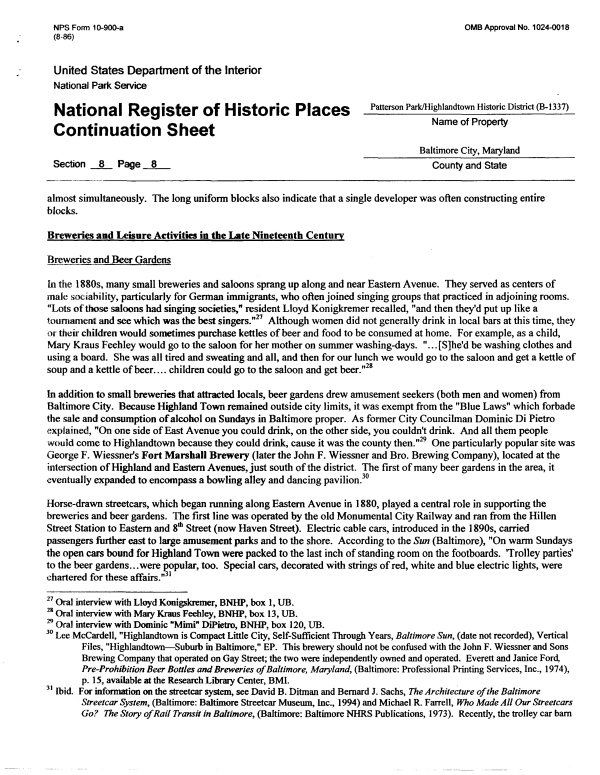 |
||||
|
DEPARTMENT OF HOUSING AND COMMUNITY DEVELOPMENT, MARYLAND HISTORICAL TRUST (Historic Sites Survey) var.d. MSA SE16-3 Image No: se16-3-0103 Enlarge and print image (85K) |
 |
||||
|
DEPARTMENT OF HOUSING AND COMMUNITY DEVELOPMENT, MARYLAND HISTORICAL TRUST (Historic Sites Survey) var.d. MSA SE16-3 Image No: se16-3-0103 Enlarge and print image (85K) |
| NPS Form 10-900-a OMB Approval No. 1024-0018 (8-86) United States Department of the Interior National Park Service National Register of Historic Places PattersonPark/HiehlandtownHist°ricDistrict(B-1337> ^ .. ,. -». . Name of Property Continuation Sheet Baltimore City, Maryland Section 8 Page__8_ County and State almost simultaneously. The long uniform blocks also indicate that a single developer was often constructing entire blocks. Breweries and Leisure Activities in the Late Nineteenth Century Breweries and Beer Gardens In the 1880s, many small breweries and saloons sprang up along and near Eastern Avenue. They served as centers of male sociability, particularly for German immigrants, who often joined singing groups that practiced in adjoining rooms. "Lots of those saloons had singing societies," resident Lloyd Konigkremer recalled, "and then they'd put up like a tournament and see which was the best singers."27 Although women did not generally drink in local bars at this time, they or their children would sometimes purchase kettles of beer and food to be consumed at home. For example, as a child, Mary Kraus Feehley would go to the saloon for her mother on summer washing-days. "...[S]he'd be washing clothes and using a board. She was all tired and sweating and all, and then for our lunch we would go to the saloon and get a kettle of soup and a kettle of beer.... children could go to the saloon and get beer."28 In addition to small breweries that attracted locals, beer gardens drew amusement seekers (both men and women) from Baltimore City. Because Highland Town remained outside city limits, it was exempt from the "Blue Laws" which forbade the sale and consumption of alcohol on Sundays in Baltimore proper. As former City Councilman Dominic Di Pietro explained, "On one side of East Avenue you could drink, on the other side, you couldn't drink. And all them people would come to Highlandtown because they could drink, cause it was the county then."29 One particularly popular site was George F. Wiessner*s Fort Marshall Brewery (later the John F. Wiessner and Bro. Brewing Company), located at the intersection of Highland and Eastern Avenues, just south of the district. The first of many beer gardens in the area, it eventually expanded to encompass a bowling alley and dancing pavilion.30 Horse-drawn streetcars, which began running along Eastern Avenue in 1880, played a central role in supporting the breweries and beer gardens. The first line was operated by the old Monumental City Railway and ran from the Hillen Street Station to Eastern and 8th Street (now Haven Street). Electric cable cars, introduced in the 1890s, carried passengers further east to large amusement parks and to the shore. According to the Sun (Baltimore), "On warm Sundays the open cars bound for Highland Town were packed to the last inch of standing room on the footboards. Trolley parties' to the beer gardens... were popular, too. Special cars, decorated with strings of red, white and blue electric lights, were chartered for these affairs."31 27 Oral interview with Lloyd Konigskremer, BNHP, box 1, UB. 28 Oral interview with Mary Kraus Feehley, BNHP, box 13, UB. 29 Oral interview with Dominic "Mimi" DiPietro, BNHP, box 120, UB. 30 Lee McCardell, "Highlandtown is Compact Little City, Self-Sufficient Through Years, Baltimore Sun, (date not recorded), Vertical Files, "Highlandtown—Suburb in Baltimore," EP. This brewery should not be confused with the John F. Wiessner and Sons Brewing Company that operated on Gay Street; the two were independently owned and operated. Everett and Janice Ford, Pre-Prohibition Beer Bottles and Breweries of Baltimore, Maryland, (Baltimore: Professional Printing Services, Inc., 1974), p. 15, available at the Research Library Center, BMI. 31 Ibid. For information on the streetcar system, see David B. Ditman and Bernard J. Sachs, The Architecture of the Baltimore Streetcar System, (Baltimore: Baltimore Streetcar Museum, Inc., 1994) and Michael R. Farrell, Who Made All Our Streetcars Go? The Story of Rail Transit in Baltimore, (Baltimore: Baltimore NHRS Publications, 1973). Recently, the trolley car barn |